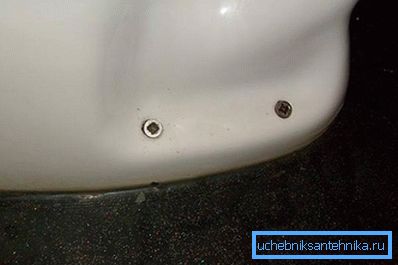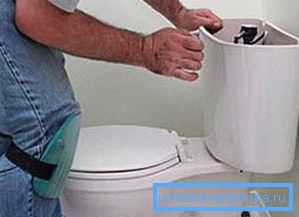Connecting the toilet to the sewer: instructions
To argue about what part of the interior of the house or apartment is the main, you can endlessly. But, perhaps, everyone will agree that in any case, without a properly installed and properly functioning toilet bowl, it will be difficult to manage. It often happens that over time, the toilet becomes unusable, or simply wants to change the plumbing, based on aesthetic considerations. The process itself is not very complicated, and it can be carried out without resorting to the services of specialists.
Fixation options

There are several options for fixing the toilet to the floor. Each of them can be applied, depending on the specific situation.
- Fastening on epoxy. This type of attachment is inherently adhesive. The resin is applied to the floor surface with a layer of 3-4 cm, and the toilet is placed on top. After polymerization of epoxy, a strong compound is obtained. You can only add that for a more reliable adhesion of surfaces, they need to be cleaned by processing with a metal brush. It should be remembered that the surface should be as clean and degreased. Epoxy resin is in stronger contact with rough surfaces.
- Fastening to the tile. If this method is used, then you must first mark the places where the connection will take place. As a rule, they are due to the design of the element itself plumbing. After that, according to the marks made, with the help of a drill with a pointy drill, holes are made into which the dowels are driven. After that, the toilet is attracted by screws. When drilling a tile, in no case should you turn on the percussion drilling mode on the punch.
- Mount to the taffeta. Taffeta is called the wooden base, which is fixed. To do this, choose a tree, hard wood, such as oak or ash. An appropriately sized board is mounted at the same level with the floor and secured with anchors. For example, it is possible to dismantle a part of the tile, in the place of the intended installation of the toilet bowl to mount the taffeta in the prepared place. As additional elements of fixation nails can be driven in through the boards.
It is necessary to decide which fastening method should be chosen individually, but regardless of it, it is worthwhile to carry out a peculiar fitting of the sanitary element.
Connection options

It should be said that the connection options will depend on the location of the drain pipe.
- Vertical.
- Horizontal
- At an angle.
If there is a replacement of the old toilet, simply look at what type of drain was in the old one. But in the case of installation in a new building or other place, you have to design it yourself. It should be said that, in principle, the connection options are not different. It is always the connection of the toilet bowl and the central drain pipe, using eccentric or corrugated nozzles. The only difference is in the direction of the installed drain pipe.
Installation and Connection Process

First, it is necessary to carry out a preliminary connection, without fixing the sanitary element to the surface. The eccentric connecting element is connected at one end to the toilet drain pipe, and the second is mounted to the central pipe. If necessary, the joints can be treated with a special silicone sealant. But, as a rule, there is no need for this, since the docking elements are provided with special rubber gaskets that provide a tight connection.
Tip! If there is no silicone on hand, then before installing the plumbing fixtures, you can lubricate the rubber cups of the sewer pipes with liquid soap.
If the displacement of the outlet pipe of the toilet bowl relative to the junction with the central pipe is too large, then you can use corrugated connecting elements that can be bent to more significant angles. It should be remembered that the length of the corrugations should be measured with a certain margin, but it is not necessary to allow excessive sagging of pipes. The joints are treated with sealants.
In cases where the angle of displacement is so large that even the use of a corrugated pipe does not solve the problem, it is necessary to design and install special plumbing wiring, for which you will need to seek the services of professional plumbers. This of course entails additional costs, however, will save time. In addition, it will eliminate the risk of breakage of the device. This is especially true in city apartments, where a leak on one of the floors when it is untimely resolved will affect several apartments at once, but in private houses there is nothing good about breaking the toilet.
Further, in accordance with the instructions, the drain tank is connected and the drain system is assembled, and the water level is also regulated. It is important to set the float at such a level that enough water is drawn for a good flush.
Tip! All joints, pipes or parts of the device where leakage is possible, must be coated with silicone sealant.
After the connection is made, you need to check the operation of the entire device. To do this, you can collect a tank of water and conduct a test drain. If everything works and no leakage is observed, then the toilet can be fixed to the floor. For fixing strength, you can combine several fixing methods, for example, you can attach to epoxy resin, additionally screwing the toilet with screws. Thus, the connection will not only be strong, but also hermetic.
All joints of pipes and parts before connecting also need to coat with sealant. When installing the cistern or while pulling the toilet down to the floor, you need not to overdo it, because excessive efforts will damage the faience, which at least spoils the appearance of the plumbing fixture, and in the future may lead to premature failure of the toilet.
After all the installation work has been completed, it is necessary to drain and collect water several times, that is, to test the operation of the device. At the same time it is necessary to carefully adjust the level of water in the drain tank. Best of all, if it does not reach the edge or the control hole about 1 cm. This amount of water is enough for the full operation of the device.